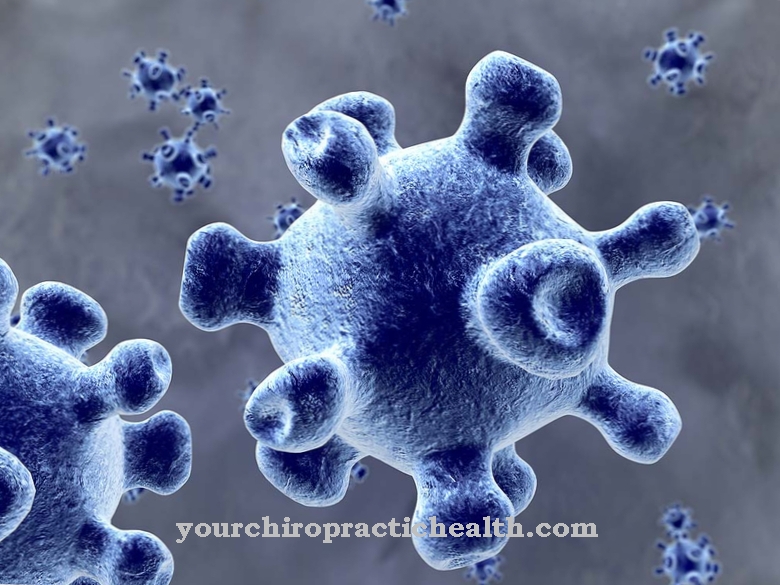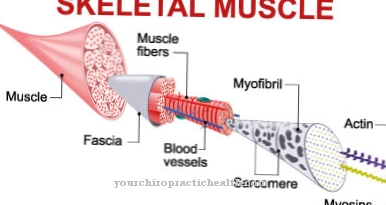About one in 5000 people in Germany suffers from one Bleeding disorder. Here are the triggers as well as the treatment of Clotting disorders very different.
What is a bleeding disorder?

© freshidea - stock.adobe.com
Blood coagulation disorders are either too weak or too strong coagulation (Hemostasis) of the blood in the event of an injury to one or more blood vessels.
Normally, the coagulation occurs due to the interplay of several factors: on the one hand, the blood vessels constrict, which is intended to contain the further influx of blood that would then escape from the wound.
On the other hand, the thrombocytes, i.e. the blood platelets, stick together at the relevant point and thus ensure rapid wound closure, which is then reinforced by the so-called fibrin threads. These threads are the product of 12 clotting factors in the blood plasma that are activated in an emergency.
If these coagulation factors are not able to function properly, there is a blood coagulation disorder, which can lead either to excessive coagulation (e.g. thrombosis) or too weak (e.g. hemophilia).
causes
There are several reasons for a bleeding disorder to occur. In some cases, a lack of blood platelets means that the damaged blood vessels are not sufficiently glued together and therefore the bleeding cannot be stopped properly.
This is e.g. the case with the so-called Von Willebrand-Jürgens syndrome. However, even if there are enough platelets, they may lack the ability to stick together. In rare cases, this malfunction can be inherited. However, it occurs far more frequently as a side effect as a result of taking certain medications.
Another cause of poor blood clotting can be the dysfunction of the clotting factors. This is the case, for example, with the famous hemophilia. Since the liver is responsible for the formation of most of the 12 coagulation factors, diseases of the liver can also be the cause of a blood clotting disorder.
Symptoms, ailments & signs
A bleeding disorder manifests itself primarily through the increased occurrence of hematomas. If there is a coagulation disorder, bruises appear after lightly tapping the skin, which usually last for several weeks. Bleeding after an injury or surgery lasts much longer than usual or occurs again after the wound has closed.
Furthermore, bleeding of various sizes can occur. Small skin hemorrhages, so-called petechiae, are typical, but also extensive wounds and bloody rashes. These symptoms clearly indicate a blood clotting disorder. Usually they lead to other physical signs. For example, prolonged bleeding becomes noticeable through the symptoms of anemia: The person affected is pale, has sunken eye sockets and is physically and mentally less productive.
Headaches, visual disturbances and joint pain can also occur as a result of the disease. Sometimes blood is noticed in the urine or stool. Depending on the degree of deficiency, swelling in the muscles and ankles can occur, which is usually associated with movement disorders and nerve pain. Gastrointestinal complaints such as nausea, vomiting and diarrhea are also typical in a blood clotting disorder. Dizziness and poor concentration can also occur.
Diagnosis & course
A bleeding disorder can have dire consequences for the person affected. Excessive coagulation can cause blood clots, for example, to form, which can then block vessels in the brain, lungs or heart.
In the worst case, this can lead to a heart attack, pulmonary embolism or stroke. On the other hand, if the blood clotting is too weak, even with small cuts or unnoticed internal bleeding, there is a great danger for those affected, as the bleeding is very difficult to stop.
Medical laboratory examinations are primarily used to detect a blood coagulation disorder, in which the activity of the blood clotting is checked, for example by determining the number of blood platelets. The number of coagulation factors in the blood can also be determined. If a lack of blood platelets is the trigger for the blood clotting disorder, a bone marrow sample is also taken to investigate the reason for the deficiency.
Complications
A bleeding disorder can mean both prolonged bleeding and shortened bleeding, both of which can have different complications. The prolonged bleeding associated with haemophilia causes bleeding in all parts of the body. For example, large amounts of blood can be lost around muscles, causing severe pain.
In the abdominal area this can be misleading and it is more likely an inflammation of the appendage (appendicitis), so that an unnecessary operation may be initiated. Heavy bleeding can also lead to compression of organs. In the area of muscles and vessels, this can lead to a compartment syndrome, which in the worst case leads to the death of the individual muscle groups.
In the neck and head area, too, bleeding typically leads to a narrowing of the airways and the affected person suffers from shortness of breath. Shortened bleeding in the context of thrombophilia increases the risk of thrombosis. Thromboses are predisposed, especially in the leg veins. These lead to severe pain and edema in the legs.
In addition, ulcers are more easily formed on the ankles and feet. In the worst cases, the thrombosis dissolves and is carried away with the bloodstream. This can lead to the lungs and brain, causing a pulmonary embolism or even a stroke.
When should you go to the doctor?
Bruises after a fall or a shock injury are harmless in most cases and do not require medical attention. You don't need to see a doctor immediately because of a slight nosebleed or small wounds. However, if larger bruises develop after a harmless collision or a light bump, caution should be exercised as this could be a sign of hemophilia, which if left untreated can become life-threatening.
People with hemophilia have impaired blood clotting and can bleed to death from major injuries or operations without medical attention. Like large bruises, frequent, heavy nosebleeds or small wounds that keep bleeding can indicate the hemophilia.
With both signs you should definitely consult a coagulation specialist, because the hemophilia must be treated with medication because those affected lack a coagulation factor for wound healing. In order not to bleed to death, they have to inject the missing coagulation factor intravenously. If a blood clotting disorder is suspected, a blood test should always be carried out. People prone to thrombosis and blood clots should also see a doctor.
Doctors & therapists in your area
Treatment & Therapy
Treatment for a bleeding disorder depends entirely on what triggers it. If there is a shortage of blood platelets, for example, these must be artificially supplied in the form of a platelet concentrate.
Since a lack of blood platelets can in rare cases be triggered by an incorrect reaction of the immune system, this must be prevented by taking immunosuppressants such as cortisone. A lack of coagulation factors can also be remedied by regular administration of a special concentrate.
If, on the other hand, external factors such as the use of medication or alcohol abuse are responsible for the disturbed blood clotting, these must of course be stopped immediately or withdrawal started. If, on the other hand, there is excessive coagulation with a tendency to form blood clots, the first thing to do is to identify the cause of this process.
These are often found in other diseases such as cancer or infections or in the sequelae of childbirth or severe blood loss. If these causes are correctly identified and combated, in most cases this also leads to the normalization of blood clotting and, as a consequence, to the disappearance of the blood clotting disorder.
Outlook & forecast
In most cases, a bleeding disorder can be treated relatively well and easily, so that the person affected can participate in a normal everyday life without complications or restrictions. However, the course of the disease also depends on the exact cause, so that a general prognosis cannot be given.
If the immune system reacts incorrectly, the blood clotting disorder is relieved relatively well by the administration of suppressants or cortisone. If you are taking other medications or if you are heavily dependent on alcohol, the primary illness must be treated or the medication in question must be replaced or discontinued.
With a correct and early detection of the cause, the bleeding disorder can be completely limited in most cases. If the blood clotting disorder occurs, those affected must always inform the treating doctor about the disorder in order to avoid excessive bleeding.
A healthy lifestyle with lots of sporting activities and a healthy diet can prevent possible thromboses due to this disorder. In the case of cancer as the cause of the bleeding disorder, as a rule no positive prediction can be made about the course of the disease. The course depends heavily on the type of cancer and its severity.
prevention
A blood clotting disorder based on the hemophilia cannot naturally be prevented. If the coagulation disorder is based on medication, discontinuation of the drug can prevent the blood coagulation disorder.
However, this should only be done in consultation with the doctor. Blood clotting disorders that can lead to thrombosis can be prevented in good time with plenty of exercise, sport and a healthy diet. Despite all of this, bleeding disorders and their possible consequences can be dangerous, but luckily they are also easy to treat.
Aftercare
Follow-up care for a blood coagulation disorder takes place by means of preventive measures and medical checks. The type of follow-up also depends on the nature of the blood clotting disorder. In almost every case it is necessary to have the flow properties of the blood checked regularly and to maintain an overview of the coagulation factors.
For people with a strong tendency to clot, follow-up care consists primarily of regular blood vessel checks. Since thromboses occur frequently, they must be discovered early. Accordingly, prophylactic administration of blood thinners can be useful. In stressful situations that involve little exercise, such as long-haul flights, for example, the administration of blood thinners is recommended.
For forms of haemophilia, follow-up care consists of clarifying abnormalities (e.g. skin discoloration, blood in the stool or urine) and urgently avoiding injuries. Medication, the administration of hormones or donor factors can be necessary for a lifetime for prophylaxis.
If internal bleeding has led to tissue damage, follow-up care consists of appropriate therapy. If muscles or bones are affected, this means that physiotherapy is used. Exercise can be useful for strengthening the joints, as these are also affected by hemophilia. Endurance sports are suitable, but contact sports are not. In the event of damage to the organs, however, follow-up care must be based on the respective damage.
You can do that yourself
Adjustments in everyday life for blood clotting disorders depend on whether the blood clotting is reduced or the blood clotting is too strong. In the case of reduced blood coagulation, which is often also deliberately produced with drugs, in the case of cardiac arrhythmias or after the implantation of artificial heart valves, there is a fundamental risk of bleeding that is difficult to stop. This can lead to complications with internal injuries. If the inadequate blood coagulation, as in so-called hemorrhages, is due to hereditary factors, a causal therapy is not possible.
In those cases in which the unwanted reduced ability of the blood to clot is due to the use of certain medications or to alcohol abuse, alternative medication or alcohol withdrawal should be considered. An important measure in artificially induced "blood thinning" by taking coagulation inhibitors is, on the one hand, the necessary increased attention in order to avoid injuries due to the high risk of bleeding.
In addition, it is advisable to have a small ID with you stating which anti-coagulation medication is being taken in which strength. This is particularly important if surgery is necessary after an accident.
In the opposite case, there is an excessive tendency to anticoagulant, there is always an increased risk of a thrombosis, a stroke or a heart attack. In order to minimize the risk of thrombosis, in addition to taking coagulation inhibitors, self-help measures can also have a preventive effect. These are sporting activities and a healthy diet to avoid vitamin and mineral deficiencies.


.jpg)



.jpg)




















